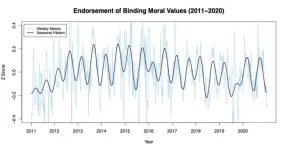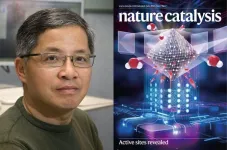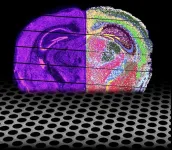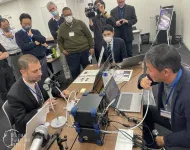(Press-News.org) A team of researchers, led by the University of Houston, has discovered two new ways of preventing and treating respiratory viruses. In back-to-back papers in Nature Communications, the team - from the lab of Navin Varadarajan, M.D. Anderson Professor of William A. Brookshire Chemical and Biomolecular Engineering - reports the development and validation of NanoSTING, a nasal spray, as a broad-spectrum immune activator for controlling infection against multiple respiratory viruses; and the development of NanoSTING-SN, a pan-coronavirus nasal vaccine, that can protect against infection and disease by all members of the coronavirus family.
NanoSTING Therapeutic HIGHLIGHTS
-- NanoSTING, a nasal spray, can prevent multiple respiratory viruses by activating the immune system and preventing infection from viruses. It can also protect against SARS-CoV-2 reinfection.
-- A single intranasal dose of the NanoSTING has proven effective against strains of SARS-CoV-2 and the flu virus.
-- NanoSTING is complementary to vaccines and enables cells to be in a heightened state of alert to prevent attack from respiratory viruses.
NanoSTING-NS Pan-coronavirus Vaccine HIGHLIGHTS
-- UH researchers have developed NanoSTING-SN, a nasal vaccine that prevents transmission to the unvaccinated and fights multiple COVID variants.
-- NanoSTING-SN provides the exciting potential towards a universal coronavirus vaccine and may end the cycle of onward transmission and viral evolution in immunocompromised people.
-- Intramuscular vaccines prevent disease but are less efficient in preventing infections. NanoSTING-SN can provide improved protection against transmission for COVID variants and related sarbecoviruses.
NanoSTING
NanoSTING is a special formula that uses tiny fat droplets to deliver an immune-boosting ingredient called cGAMP. This formula helps the body's cells stay on high alert to prevent attack from respiratory viruses.
“Using multiple models, the team demonstrated that a single treatment with NanoSTING not only protects against pathogenic strains of SARS-CoV-2 but also prevents transmission of highly transmissible variants like the Omicron variants,” reports Varadarajan. “Delivery of NanoSTING to the nose ensures that the immune system is activated in the nasal compartment and this in turn prevents infection from viruses.”
As the recent COVID19 pandemic illustrated, the development of off-the-shelf treatments that counteract respiratory viruses is a largely unsolved problem with a huge impact on human lives.
“Our results showed that intranasal delivery of NanoSTING, is capable of eliciting beneficial type I and type III interferon responses that are associated with immune protection and antiviral benefit,” reports first author and postdoctoral associate, Ankita Leekha.
The authors further show that NanoSTING can protect against both Tamiflu sensitive and resistant strains of influenza, underscoring its potential as a broad-spectrum therapeutic.
“The ability to activate the innate immune system presents an attractive route to armoring humans against multiple respiratory viruses, viral variants and also minimizing transmission to vulnerable people,” said Leekha. “The advantage of NanoSTING is that only one dose is required unlike the antivirals like Tamiflu that require 10 doses.”
The mechanism of action of NanoSTING is complementary to vaccines, monoclonal antibodies and antivirals, the authors noted.
Nano STING-SN
Despite the successful implementation of multiple vaccines against SARS-CoV-2, these vaccines need constant updates due to viral evolution, plus the current generation of vaccines only offers limited protection against transmission of SARS-CoV-2.
Enter NanoSTING-SN, a multi-antigen, intranasal vaccine, that eliminates virus replication in both the lungs and the nostrils and has the ability to protect against multiple coronaviruses and variants.
“Using multiple preclinical models, the team demonstrated that the vaccine candidate protects the primary host from disease when challenged with highly pathogenic variants. Significantly, the vaccine also prevents transmission of highly transmissible variants like the Omicron variants to vaccine-naïve hosts,” reports Varadarajan.
The authors further show that the nasal vaccine was 100% effective at preventing transmission of the Omicron VOCs to unvaccinated hosts.
“The ability to protect against multiple coronaviruses and variants provides the exciting potential towards a universal coronavirus vaccine,” said Leekha. “The ability to prevent infections and transmission might finally end this cycle of onward transmission and viral evolution in immunocompromised people.”
The research was conducted by a collaborative team at UH including Xinli Liu, College of Pharmacy and Vallabh E. Das, College of Optometry along with Brett L. Hurst of Utah State University and consultation from AuraVax Therapeutics, a spinoff from Varadarajan’s Single Cell Lab at UH, which is developing NanoSTING.
Funding for the studies was provided by NIH (R01GM143243), Owens Foundation, and AuraVax Therapeutics.
END
University of Houston researchers create new treatment and vaccine for flu and various coronaviruses
Team develops two nasal sprays – an immune activator and a new vaccine – to prevent virus transmission
2024-08-06
ELSE PRESS RELEASES FROM THIS DATE:
People's moral values change with the seasons
2024-08-06
A new UBC study has revealed regular seasonal shifts in people’s moral values.
The finding has potential implications for politics, law and health—including the timing of elections and court cases, as well as public response to a health crisis.
The research published this week in Proceedings of the National Academy of Sciences (PNAS) analyzed survey responses from more than 230,000 people in the U.S. over 10 years and revealed that people’s embrace of certain moral ...
Researchers reveal atomic-scale details of catalysts’ active sites
2024-08-06
The chemical and energy industries depend upon catalysts to drive the reactions used to create their products. Many important reactions use heterogeneous catalysts — meaning that the catalysts are in a different phase of matter than the substances they are reacting with, such as solid platinum reacting with gases in an automobile’s catalytic converter.
Scientists have investigated the surface of well-defined single crystals, illuminating the mechanisms underlying many chemical reactions. However, there is much more to be learned. For heterogeneous catalysts, their 3D atomic structure, their chemical composition and the nature of ...
The prescription for a healthier democracy
2024-08-06
When we’re sick, the first step on the road to recovery is a visit to the doctor’s office.
It turns out the same may also be true for breathing life into America’s democracy.
A Rutgers University–New Brunswick study published in the journal JAMA Health Forum finds that physicians can play a crucial role in strengthening political inclusion of marginalized groups by aiding patients in voter registration.
“Hospitals aren’t the first place we think of when it comes to voter registration,” said Katherine McCabe, an associate professor of American politics at Rutgers University-New Brunswick and lead ...
New substrate material for flexible electronics could help combat e-waste
2024-08-06
Electronic waste, or e-waste, is a rapidly growing global problem, and it’s expected to worsen with the production of new kinds of flexible electronics for robotics, wearable devices, health monitors, and other new applications, including single-use devices.
A new kind of flexible substrate material developed at MIT, the University of Utah, and Meta has the potential to enable not only the recycling of materials and components at the end of a device’s useful life, but also the scalable manufacture of more ...
Johns Hopkins Medicine scientists probe molecular cause of COVID-19 related diarrhea, revealing potential treatments
2024-08-06
Working with human stem cells that form a kind of “mini intestine-in-a-dish,” Johns Hopkins Medicine scientists say they have found several molecular mechanisms for COVID-19-related diarrhea, suggesting potential ways to control it.
Details of the experiments in a model of human intestinal tissue, called enteroids, are described on July 30 in Cellular and Molecular Gastroenterology and Hepatology.
Along with the unpleasant aches, fever, sore throat, cough, respiratory distress and other symptoms that may accompany COVID-19 infection, up to half of people who get the virus will experience diarrhea. Some 30% of them will go on to develop ...
New open-source platform for high-resolution spatial transcriptomics
2024-08-06
Leuven, 6 August 2024 - A team of researchers from the lab of Prof. Stein Aerts (VIB-KU Leuven) presents Nova-ST, a new spatial transcriptomics technique that promises to transform gene expression profiling in tissue samples. Nova-ST will make large-scale, high-resolution spatial tissue analysis more accessible and affordable, offering significant benefits for researchers. The research was published in Cell Reports Methods.
Transcriptomics is the study of gene expression in a cell or a population of cells, but it usually does not include spatial information about where those genes were active. This hurdle limited our understanding of complex ...
Targeted cancer therapy: initial high concentration may slow down selection for resistance
2024-08-06
BUFFALO, NY- August 6, 2024 – On July 28, 2024, Mikhail V. Blagosklonny M.D., Ph.D., from Roswell Park Comprehensive Cancer Center published a new editorial in Volume 16, Issue 14 of Aging (listed by MEDLINE/PubMed as "Aging (Albany NY)" and "Aging-US" by Web of Science), entitled, “Targeted cancer therapy: the initial high concentration may slow down the selection for resistance.”
“Unfortunately, any targeted therapy is, always, started with low levels of the drug in the organism, selecting for drug resistance. One should propose that initial drug levels must be maximized, ...
Lehigh University researchers dig deeper into stability challenges of nuclear fusion—with mayonnaise
2024-08-06
Mayonnaise continues to help researchers better understand the physics behind nuclear fusion.
“We’re still working on the same problem, which is the structural integrity of fusion capsules used in inertial confinement fusion, and Hellmann’s Real Mayonnaise is still helping us in the search for solutions,” says Arindam Banerjee, the Paul B. Reinhold Professor of Mechanical Engineering and Mechanics at Lehigh University and Chair of the MEM department in the P.C. Rossin College of Engineering and Applied Science.
In simple terms, fusion reactions are what power the sun. If the process could ...
Texas Tech professor receives grant for printable semiconductors research
2024-08-06
Minxiang “Glenn” Zeng, an assistant professor in the Department of Chemical Engineering at Texas Tech University, has been awarded a $250,000 grant from the Launching Early-Career Academic Pathways in the Mathematical and Physical Sciences (LEAPS-MPS) award from the National Science Foundation (NSF) to further his research about printable semiconductors and electronics under extreme environments.
The grant supports Zeng’s work in understanding and controlling the thermal degradation pathways of printed metal chalcogenides, which are semiconductor materials including selenides, tellurides and sulfides. His goal is to develop strategies to enhance the thermal stability ...
Digital Olfaction Society 2024: Revolutionizing scent digitization and global transfer
2024-08-06
The 8th Annual Meeting of the Digital Olfaction Society (DOS) will take place on December 5-6, 2024, in Tokyo, Japan, and Online. The DOS meeting is uniquely aimed at digitizing scents, transferring them, and re-creating them in different parts of the world. The two-day event includes one day dedicated to talks and another day for demonstrations. Under the slogan "Olfaction to Digital Olfaction", the congress will explore the latest advances in olfaction science and digital olfaction technologies, highlighting their transformative impact across multiple fields.
The first day of the congress will focus on olfaction science, scent-based diagnosis and treatment ...
LAST 30 PRESS RELEASES:
Numbers in our sights affect how we perceive space
SIMJ announces global collaborative book project in commemoration of its 75th anniversary
Air pollution exposure and birth weight
Obstructive sleep apnea risk and mental health conditions among older adults
How talking slows eye movements behind the wheel
The Ceramic Society of Japan’s Oxoate Ceramics Research Association launches new international book project
Heart-brain connection: international study reveals the role of the vagus nerve in keeping the heart young
Researchers identify Rb1 as a predictive biomarker for a new therapeutic strategy in some breast cancers
Survey reveals ethical gaps slowing AI adoption in pediatric surgery
Stimulant ADHD medications work differently than thought
AI overestimates how smart people are, according to HSE economists
HSE researchers create genome-wide map of quadruplexes
Scientists boost cell "powerhouses" to burn more calories
Automatic label checking: The missing step in making reliable medical AI
Low daily alcohol intake linked to 50% heightened mouth cancer risk in India
American Meteorological Society announces Rick Spinrad as 2026 President-Elect
Biomass-based carbon capture spotlighted in newly released global climate webinar recording
Illuminating invisible nano pollutants: advanced bioimaging tracks the full journey of emerging nanoscale contaminants in living systems
How does age affect recovery from spinal cord injury?
Novel AI tool offers prognosis for patients with head and neck cancer
Fathers’ microplastic exposure tied to their children’s metabolic problems
Research validates laboratory model for studying high-grade serous ovarian cancer
SIR 2026 delivers transformative breakthroughs in minimally invasive medicine to improve patient care
Stem Cell Reports most downloaded papers of 2025 highlight the breadth and impact of stem cell research
Oxford-led study estimates NHS spends around 3% of its primary and secondary care budget on the health impacts of heat and cold in England
A researcher’s long quest leads to a smart composite breakthrough
Urban wild bees act as “microbial sensors” of city health.
New study finds where you live affects recovery after a hip fracture
Forecasting the impact of fully automated vehicle adoption on US road traffic injuries
Alcohol-related hospitalizations from 2016 to 2022
[Press-News.org] University of Houston researchers create new treatment and vaccine for flu and various coronavirusesTeam develops two nasal sprays – an immune activator and a new vaccine – to prevent virus transmission






